
Cake is a flour confection made from flour, sugar, and other ingredients and is usually baked. In their oldest forms, cakes were modifications of bread, but cakes now cover a wide range of preparations that can be simple or elaborate and which share features with desserts such as pastries, meringues, custards, and pies.
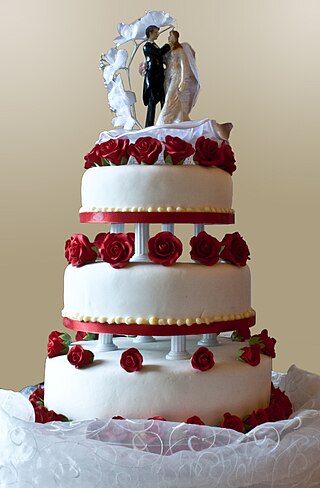
A wedding cake is the traditional cake served at wedding receptions following dinner. In some parts of England, the wedding cake is served at a wedding breakfast; the 'wedding breakfast' does not mean the meal will be held in the morning, but at a time following the ceremony on the same day. In modern Western culture, the cake is usually on display and served to guests at the reception. Traditionally, wedding cakes were made to bring good luck to all guests and the couple. Nowadays, however, they are more of a centerpiece to the wedding and are not always even served to the guests. Some cakes are built with only a single edible tier for the bride and groom to share, but this is rare since the cost difference between fake and real tiers is minimal.

Cheesecake is a dessert made with a soft fresh cheese, eggs, and sugar. It may have a crust or base made from crushed cookies, graham crackers, pastry, or sometimes sponge cake. Cheesecake may be baked or unbaked, and is usually refrigerated.

A mille-feuille, also known by the names Napoleon in North America, vanilla slice in the United Kingdom, and custard slice, is a French dessert made of puff pastry layered with pastry cream. Its modern form was influenced by improvements made by Marie-Antoine Carême.

German chocolate cake, originally German's chocolate cake, is a layered chocolate cake filled and topped with a coconut-pecan frosting. Originating in the United States, it was named after English-American chocolate maker Samuel German, who developed a formulation of dark baking chocolate that came to be used in the cake recipe. Sweet baking chocolate is traditionally used for the cake's flavor, but few recipes call for it today. The filling and/or topping is a custard made with egg yolks and evaporated milk; once the custard is cooked, coconut and pecans are stirred in. Occasionally, a chocolate frosting is spread on the sides of the cake and piped around the circumference of the layers to hold in the filling. Maraschino cherries are occasionally added as a garnish.

Black Forest gâteau, also called Black Forest cake, is a German chocolate and cream cake with a rich cherry filling. While it is most likely based on a Black Forest dessert tradition, the cake's specific origin in Germany is contested.

A layer cake or sandwich cake is a cake consisting of multiple stacked sheets of cake, held together by frosting or another type of filling, such as jam or other preserves. Most cake recipes can be adapted for layer cakes; butter cakes and sponge cakes are common choices. Frequently, the cake is covered with icing, but sometimes, the sides are left undecorated, so that the filling and the number of layers are visible.

A génoise, also known as Genoese cake or Genovese cake, is a French sponge cake named after the city of Genoa and associated with French cuisine. It was created by François Massialot in the late 17th century. Instead of using chemical leavening, air is suspended in the batter during mixing to provide volume.
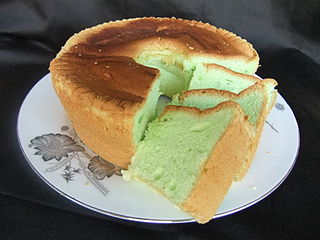
Pandan cake is a light, fluffy, green-coloured sponge cake flavoured with the juices of Pandanus amaryllifolius leaves. It is also known as pandan chiffon. The cake is popular in Indonesia, Malaysia, Singapore, Vietnam, Cambodia, Laos, Thailand, Sri Lanka, Hong Kong, China, and also the Netherlands, especially among the Indo community, due to its historical colonial ties with Indonesia. It is similar to the buko pandan cake of the Philippines, but differs in that it does not use coconut.

Dobos torte, also known as Dobosh, is a Hungarian sponge cake layered with chocolate buttercream and topped with caramel. The layered pastry is named after its inventor, Hungarian chef József C. Dobos, a delicatessen owner in Budapest. In the late 1800s, he decided to create a cake that would last longer than other pastries in an age when cooling techniques were limited. The round sides of the cake are coated with ground hazelnuts, chestnuts, walnuts, or almonds, and the hardened caramel top helps to prevent drying out, for a longer shelf life.

Doberge cake is a layered dessert originating in New Orleans, Louisiana, U.S., adapted by local baker Beulah Ledner from the Hungarian Dobos torte. Still popular in the area, the cake is made of multiple thin layers of cake alternating with dessert pudding. Very often the cakes are made with half chocolate pudding and half lemon pudding. They are covered in a thin layer of butter cream and a fondant shell or, alternatively, a poured glaze on the outside. They are normally made with six or more layers. Traditional flavors are chocolate, lemon or caramel.
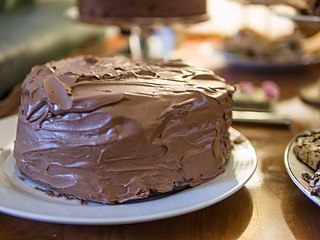
A fudge cake is a chocolate cake, which, despite its name, does not contain fudge. It instead seeks to mirror the taste of chocolate fudge. It is commonly eaten at celebrations, parties, or gatherings.
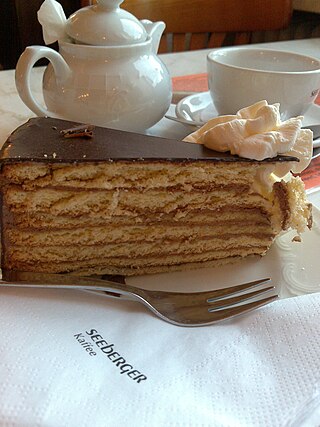
Prinzregententorte is a Bavarian torte consisting of at least six, usually seven, thin layers of sponge cake interlaid with chocolate buttercream. The exterior is covered in a dark chocolate glaze. Prinzregententorte is very popular in Bavaria, Germany, and available in cake shops all year round.

Sponge cake is a light cake made with egg whites, flour and sugar, sometimes leavened with baking powder. Some sponge cakes do not contain egg yolks, like angel food cake, but most of them do. Sponge cakes, leavened with beaten eggs, originated during the Renaissance, possibly in Spain. The sponge cake is thought to be one of the first non-yeasted cakes, and the earliest attested sponge cake recipe in English is found in a book by the English poet Gervase Markham, The English Huswife, Containing the Inward and Outward Virtues Which Ought to Be in a Complete Woman (1615). Still, the cake was much more like a cracker: thin and crispy. Sponge cakes became the cake recognised today when bakers started using beaten eggs as a rising agent in the mid-18th century. The Victorian creation of baking powder by English food manufacturer Alfred Bird in 1843 allowed the addition of butter to the traditional sponge recipe, resulting in the creation of the Victoria sponge. Cakes are available in many flavours and have many recipes as well. Sponge cakes have become snack cakes via the Twinkie.

Esterházy torta is a Hungarian cake (torte) named after Prince Paul III Anton Esterházy de Galántha (1786–1866), a member of the Esterházy dynasty and diplomat of the Austrian Empire. It was invented by Budapest confectioners in the late 19th century and soon became one of the most famous cakes in the lands of the Austro-Hungarian Monarchy.
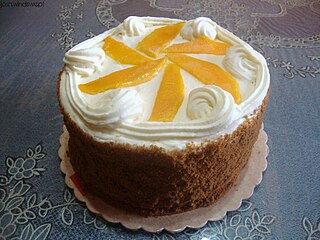
Mango cake or mango chiffon cake, is a Filipino layered chiffon cake infused with ripe sweet Carabao mangoes. It is typically topped with mango cream frosting, fresh mango slices, or pureed mangoes in gulaman or gelatin. Other common toppings include cream, cream cheese, and chocolate. It also commonly sandwiches slices of mangoes between the layers. It is one of the most popular cake variants in the Philippines, where mangoes are abundant year-round. Commercial versions are also available in large bakery chains like Red Ribbon Bakeshop and Goldilocks Bakeshop, as well as individual recipes from restaurants, often with unique names. It is very similar to crema de mangga, except that mango cake uses layers of chiffon cake not broas or graham crackers. The two recipes can sometimes be combined, however.

Orange creamsicle cake is a cake containing orange and vanilla flavors that is named after the Popsicle-brand "Creamsicle" ice cream treat on a stick: a vanilla ice cream center coated in orange-flavored popsicle ice. A traditional version might just be an orange- and vanilla-flavored bundt cake, but there are no-bake versions of the cake made with ice cream and pudding, and other versions made with cakes that are frosted or served with orange marmalade.
Watergate cake is a pistachio cake popular in the U.S. which shares its name with the Watergate scandal of the 1970s, although the name's origin is not clear. The cake pre-dates Watergate salad, a dessert made with similar ingredients including pistachio pudding.

















